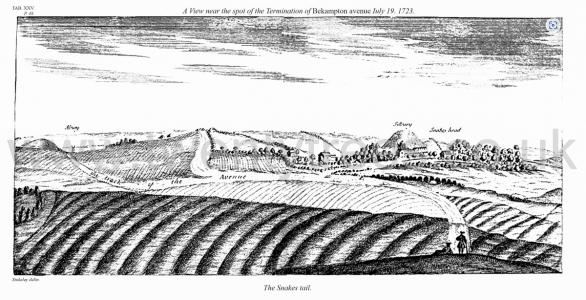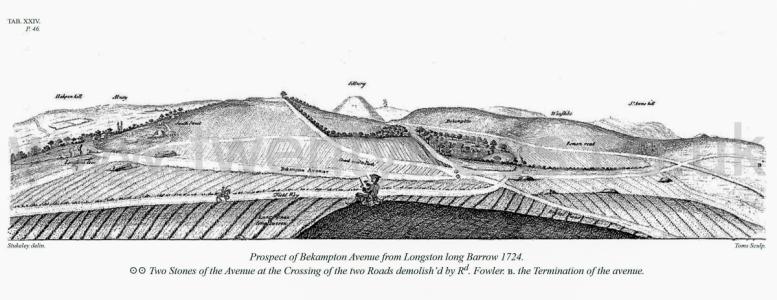Europe, British Isles, South-West England, Wiltshire, Avebury Henge and Stones, Beckhampton Avenue
Beckhampton Avenue is in Avebury Henge and Stones [Map], Avebury Avenues.
The Beckhampton Avenue is an Avenue described by William Stukeley as connecting from Avebury Henge to the Long Stones Cove aka Devil's Quoits [Map]. At his time only thirty stones remained. Since then all have gone.
Avebury by William Stukeley. A description of the other great avenue from Bekamton, a mile off, which is the hinderpart of the snake, proceeding from the circle. The cove [Map] on the midway of it called Longstones, or the Devil's coits. The avenue terminated in a valley. Some animal bones found in a stone, whence a conjecture concerning their age. Of the number of the stones. Solomon's temple compared with ours. The mechanicks of the Druids called magick. Of the effect of the weather upon the stones.
Avebury by William Stukeley. Table XXV. A View near the spot of the Termination of Bekampton avenue July 19. 1723. The Snakes tail.

Avebury by William Stukeley. 1724. Table XXIV. Prospect of Bekampton Avenue from Longston long Barrow [Map] 1724. Two Stones of the Avenue at the Crossing of the two Roads demolished by Rd. Fowler. b. the Termination of the avenue.

Colt Hoare 1812. Having now, according to the words of Stukeley, "conducted one half, the forepart of the Snake, in this mighty work, up to Overton hill, where it reposed its bulky head, and not long ago, made a most beautiful appearance," shall proceed towards that part of the Snake which designated the tail, and which has been distinguished by the title of Beckhampton Avenue, and investigated by the same learned author in the year 1722.
"Beckhampton Avenue goes out of Abury town at the west point, and proceeds by the south side of the church-yard. Two stones lie by the parsonage gate on the right hand; those opposite to them, on the left hand, in a pasture, were taken away in 1702, as marked in the ground plan of Abury. Reuben Horsal remembers three standing in the pasture. One now lies in the floor of a house in the church-yard. A little farther, one lies at the corner of the next house on the right hand, by the lane turning off to the right to the bridge. Another was broke in pieces to build that house with, in 1714; two more lie on the left hand opposite. It then passes the beck south of the bridge. Most of the stones hereabouts have been made use of about the bridge, and the causeway leading to it. Now the avenue passes along a lane to the left hand of the Caln road, by a stone house called Goldsmith's farm, and so through farmer Griffn's yard, through one barn that stands across the avenue, then by another which stands on its direction. Two stones and their opposites still lie in the foundation: immediately after this, it enters the open ploughed fields, the Caln road running all this while north of it. If we look back, and observe the bearings of Abury steeple, and other objects, a discerning eye finds, that it makes a great sweep, or curve the avenue entering the open corn fields, runs for some time by the hedge on the right hand. When it has crossed the way leading from South-street, we discem here and there the remains of it, in its road to Longstone Cove [Map]. Farmer Griffin broke near twenty of the Stones belonging to this part of the avenue.
Wiltshire Archaeological Magazine 1857 V4 Pages 307-363. The Beckhampton Avenue
The Beckhampton avenue which, according to Stukeley, formed the tail of the sacred reptile, and like the other, was composed, as he calculated, of 200 stones, left the vallum nearly at the W. point, and passing by the south side of what is now the churchyard, took the direction of Beckhampton. It was about the same length as the Kennet avenue, and narrowing gradually ended (as he believed), in a single stone in a low valley onthedown between the Devizes and Calne roads, near a fine group of barrows.' Stukeley speaks of ten stones of this avenue known to have been standing within memory, between the exit of the avenue from the vallum and the brook. Four stones were visible between this point and the entrance of the avenue upon the open cultivated fields. "When it has cross'd the way leading from South street, we discern here and there the remains of it, in its road to Longstone Cove. Farmer Griffin broke near 20 of the stones of this part of the avenue."
Wiltshire Archaeological Magazine 1878 V17 Pages 327-335. The Beckhampton avenue was also visible, though not so perfect as the other, in the memory of the late Mr. John Clements1 (aged eighty-one at the time of his death), who could clearly point it out. This had been chiefly demolished by Farmer Griffin, and Richard Fowler. The two stones in the cove [Map]2 are all that now remain, and with diffculty they were saved by applying from the farmer to the landlord. Mr. John Brown is now the owner of this estate."
Stukeley's account of this latter avenue derives not unimportant confirmation from these recollections of the "ancient Clements," who probably in his boyhood was an eyewitness of Dr. Stukeley's surveys.
Note 1. John Clements was a grocer in Abury aud born in 1714. The two hundred years, from John Aubrey's early visits to the present time, are bridged over by the lives of three persons residing at or near Abury, viz., "Parson Brunsdon," John Clements, and the Rev. Charles Lucas.
Note 2. The lesser and more northern of these stones did not belong to the cove.
Wiltshire Archaeological Magazine 1879 V18 Pages 377-383. Avebury — The Beckhampton Avenue. By the Rev. Bryan King (age 66), M.A.
Wiltshire Archaeological Magazine 1907 V35 Pages 515-517. Avebury, Orientation of the Avenues. Sir Norman Lockyer, in Nature, Jan. 16tb, 1908, pp. 249—251.
dealing with the alignment of the Avebury Avenues [West Kennet Avenue and Beckhampton Avenue], and their significance, says " I have measured several avenues since ' Stonehenge' was published, and I have studied others of which the. orientation could be deteimined by the Ordnance Maps. Many of them have been found to have had the same astronomical use which had been suggested in those measured on Dartmoor." He then takes the course of the Beckhampton avenue as according to Stukeley passing by the south side of the churchyard, and finds that a line " joining the two large monoliths at the west end of the Beckhampton avenue and the Cove (in the centre of the northern circle) . . passes close to the stones indicated by Stukeley." He then gives Stukeley's desci'iption of this avenue : and continues " It will be seen that the May Year Avenue line is directed nearlj-, but not quite, to the centre of the northern circle, the Cove occupying the centre itself, so block- ing the view from the avenue or processional road to the S.W." He then deals with theKennetA venue, after quoting Stukeley's andLong's accounts of it : " As will be seen from the map [a photo from the 25in. ordnance survey], this avenue apparentlj' was connected with the southern circle as the Beckhampton one was with the northern one. If this were so, certainly the enormous bank, erected apparently for spectacular purposes, which is such a striking feature of Avebury, was not made until after the Kennet avenue had fallen out of any astronomical use . . This avenue seems to have struck another aligned from the circle on Overton Hill, which formerly M'as oriented to the May sunset or the November sunrise to judge from the positions of the stones given in Smith's map."
Antiquity 1936 Volume 10 Issue 40 Pages 417-427. A second avenue, ‘The Beckhampton Avenue’, has sometimes been claimed to have run to the Avebury circles from the southwest, where two stones, ‘The Longstones [Map]’, stand, and were considered by Stukeley to be part of such an avenue. In the writers’ opinion, however, it seems more likely that, as originally suggested by Schuchhardt many years ago,1 the Beckhampton standing stones represent the remains of an independent stone circle with an avenue, of which Stukeley saw the remains, running from it towards the Kennet. It seems very improbable that an avenue to the Avebury Circles should have crossed the river as the assumed Beckhampton course would make it do, and the suggested interpretation has parallels at Stanton Drew, and, indeed, at Stonehenge itself.
Note 1. Prähistorisch Zeitschrift, 1910, II, 315.